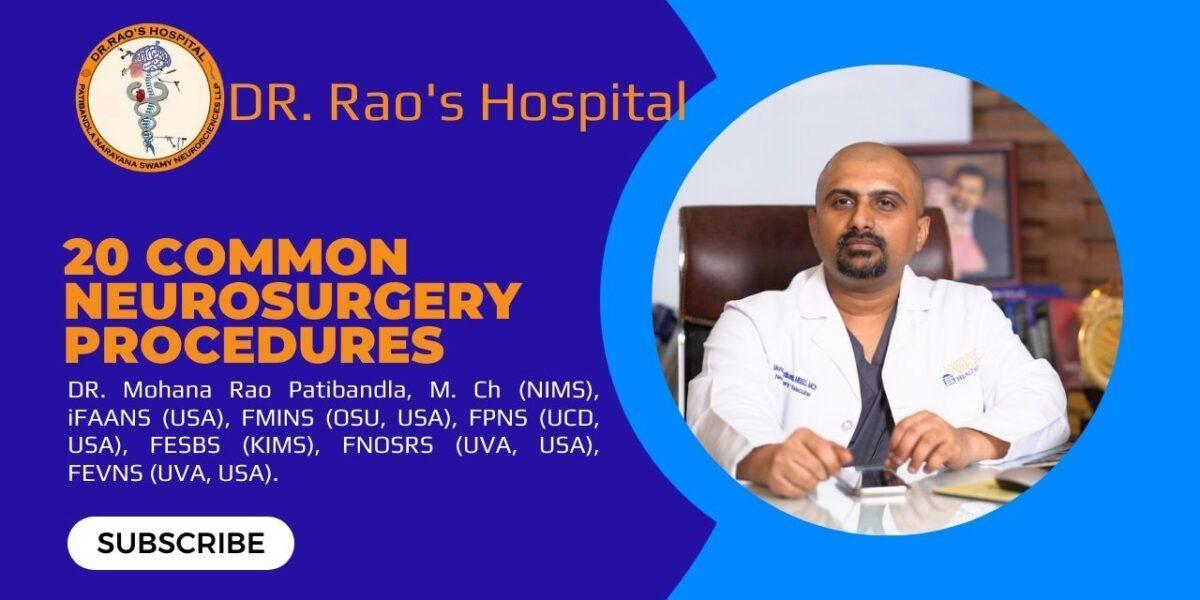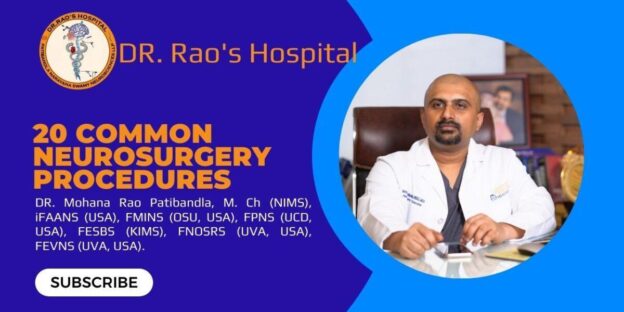Neurosurgery: 20 Most Common Neurosurgical Procedures at Dr. Raos
Explore the 20 most common neurosurgical procedures and learn how skilled neurosurgeon Dr. Rao at Dr. Rao’s Hospital provides excellent care in India.
Neurosurgery is a specialized field of medicine that focuses on diagnosing and treating conditions affecting the nervous system. From brain tumors to spinal cord injuries, neurosurgeons like Dr. Rao at Dr. Rao’s Hospital play a crucial role in improving patients’ lives. This blog will explore 20 of the most common neurosurgical procedures, shedding light on their purpose and how they are performed.
Craniotomy: Opening the Skull for Access
A craniotomy is a surgical procedure that involves removing a portion of the skull to gain access to the brain. It is performed to treat conditions such as brain tumors, aneurysms, or blood clots. Dr. Rao utilizes advanced techniques and tools to open and close the skull safely, ensuring minimal damage to surrounding tissues.
Brain Tumor Resection: Removing Abnormal Growths
Brain tumor resection is the surgical removal of a tumor from the brain. Dr. Rao employs sophisticated imaging technologies to locate and remove the tumor while preserving healthy brain tissue. This procedure aims to reduce tumor size, relieve symptoms, and improve the patient’s overall prognosis.
Spinal Fusion: Stabilizing the Spine
Spinal fusion uses bone grafts or implants to join two or more vertebrae. It is commonly used to treat spinal instability, fractures, or degenerative conditions. Dr. Rao utilizes surgical techniques to promote fusion and stability, alleviating pain and restoring spinal function.
Diskectomy: Relieving Nerve Compression
Diskectomy is a surgical procedure performed to remove a portion of a herniated or damaged spinal disk that is causing nerve compression and pain. Dr. Rao carefully removes the affected disk material, relieving pressure on the nerves and reducing symptoms such as pain, numbness, or weakness.
Deep Brain Stimulation: Managing Movement Disorders
Deep brain stimulation (DBS) manages movement disorders such as Parkinson’s disease or essential tremors. It involves implanting a neurostimulator device that delivers electrical impulses to specific brain areas. Dr. Rao precisely places the electrodes and adjusts the stimulation settings to help control symptoms and improve quality of life.
Endoscopic Brain Surgery: Minimally Invasive Approach
Endoscopic brain surgery is a minimally invasive procedure that allows access to the brain through small incisions. It is used for various conditions, including brain tumors, hydrocephalus, or cysts. Dr. Rao utilizes an endoscope, a thin tube with a camera and light source, to visualize and treat the affected area, resulting in less scarring and faster recovery.
Stereotactic Radiosurgery: Non-Invasive Tumor Treatment
Stereotactic radiosurgery is a non-invasive procedure that delivers precise radiation to target and treats tumors in the brain or spine. Dr. Rao utilizes advanced imaging techniques and specialized equipment to deliver high doses of radiation with minimal damage to surrounding healthy tissues. It is commonly used for small tumors or inoperable cases.
Shunt Placement: Managing Hydrocephalus
Shunt placement is a procedure used to treat hydrocephalus, a condition characterized by an accumulation of cerebrospinal fluid in the brain. Dr. Rao creates a pathway for excess fluid to be diverted from the brain to another part of the body, relieving pressure and managing the condition effectively.
Microdiscectomy: Minimally Invasive Spinal Surgery
Microdiscectomy is a minimally invasive surgical procedure used to remove a portion of a herniated disk in the spine that is causing nerve compression and pain. Dr. Rao utilizes small incisions and specialized tools to remove the disc through a small incision.
Carotid Endarterectomy: Restoring Blood Flow to the Brain
Carotid endarterectomy is a procedure performed to remove plaque buildup from the carotid arteries, which supply blood to the brain. It is used to prevent strokes caused by reduced blood flow. Dr. Rao carefully removes the plaque and restores proper blood flow, reducing the risk of stroke and improving overall brain health.
Ventriculoperitoneal Shunt: Treating Hydrocephalus
Ventriculoperitoneal (VP) shunt placement is a surgical procedure to treat hydrocephalus by diverting excess cerebrospinal fluid from the brain’s ventricles to the abdominal cavity. Dr. Rao inserts a shunt system consisting of a tube and valve to regulate the flow and relieve pressure on the brain.
Laminectomy: Decompressing the Spinal Canal
Laminectomy is a surgical procedure that involves removing the lamina, a portion of the vertebral bone, to relieve pressure on the spinal cord and nerves. It is commonly used to treat spinal stenosis or herniated disks. Dr. Rao carefully removes the affected bone or tissue, creating more space within the spinal canal.
Nerve Decompression Surgery: Relieving Nerve Compression
Nerve decompression surgery alleviates nerve compression and relieves symptoms such as pain, numbness, or weakness. It is commonly used to treat conditions like carpal tunnel syndrome or peripheral nerve entrapment. Dr. Rao carefully identifies and releases the compressed nerve from surrounding structures, restoring normal nerve function.
Cranioplasty: Restoring Skull Integrity
Cranioplasty is a surgical procedure performed to reconstruct or repair a defect in the skull. It may be necessary after a traumatic brain injury or a previous craniotomy. Dr. Rao uses specialized materials to restore the integrity and shape of the skull, protecting the brain and improving overall aesthetics.
Neuroendoscopy: Minimally Invasive Brain Exploration
Neuroendoscopy is a minimally invasive procedure to visualize and treat various brain conditions. It involves using an endoscope, a flexible tube with a camera and light source, to access the brain through small incisions. Dr. Rao uses this technique to diagnose and treat hydrocephalus, brain tumors, or cysts.
Transsphenoidal Surgery: Treating Pituitary Tumors
Transsphenoidal surgery is a specialized procedure to remove pituitary tumors through the nose. Dr. Rao accesses the tumor by creating a small opening in the sphenoid bone, allowing for precise tumor removal while minimizing damage to surrounding structures. This approach results in faster recovery and minimal scarring.
Radiofrequency Ablation: Targeted Pain Relief
Radiofrequency ablation (RFA) is a procedure used to provide targeted pain relief by disrupting nerve signals. It is commonly used for chronic back pain or trigeminal neuralgia. Dr. Rao uses heat generated by radiofrequency waves to selectively ablate the nerves responsible for transmitting pain signals.
Awake Brain Mapping: Preserving Brain Function
Awake brain mapping is a specialized technique used during brain surgery to map functional areas of the brain while the patient is awake. It allows Dr. Rao to identify critical areas responsible for language, movement, or sensory perception and avoid damage during tumor resection or other procedures.
Vertebral Augmentation: Treating Spinal Compression Fractures
Vertebral augmentation procedures, such as vertebroplasty and kyphoplasty, treat spinal compression fractures caused by osteoporosis or trauma. Dr. Rao injects bone cement into the fractured vertebra to augment and maintain strength to relieve pain.
Hemispherectomy: Treating Severe Epilepsy
Hemispherectomy is a complex surgical procedure to treat severe epilepsy unresponsive to medication. It involves the removal or disconnection of one hemisphere of the brain. Dr. Rao carefully evaluates the patient’s condition and determines if hemispherectomy is the most suitable option to control seizures and improve the patient’s quality of life.
These are just a few examples of the many neurosurgical procedures performed by skilled neurosurgeons like Dr. Rao at Dr. Rao’s Hospital. Each procedure is tailored to the patient’s needs and requires a multidisciplinary approach involving imaging technologies, surgical techniques, and post-operative care.
Remember, it is essential to consult with a qualified neurosurgeon to determine the most appropriate treatment plan for your specific condition. Dr. Rao’s expertise and experience make him an excellent choice for patients seeking the best neurosurgical care in India.
Tags: neurosurgery, common procedures, brain surgery, spine surgery, Dr. Rao, best neurosurgeon, Dr. Rao’s Hospital, medical procedures, surgical treatments, YouTube Tags: neurosurgery, common procedures, brain surgery, spine surgery, Dr. Rao, best neurosurgeon, Dr. Rao’s Hospital, medical procedures, surgical treatments, neurosurgical techniques


